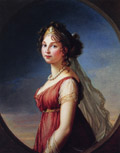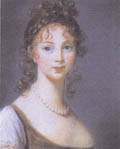
"My Beautiful Enemy"
 "My Beautiful Enemy" |
(Text reprinted from a 1992 Christies, London Catalog)
These Pastels are listed in Neil Jeffares' Dictionary of Pastellists before 1800.
A Biography of Queen Louise of Prussia
Born March 10, 1776, the daughter of Prince Charles Louis Frederick of Mecklenburg-Strelitz and Princess Frederica Caroline Louise of Hesse-Darmstadt, Augusta Wilhelmina Louise was destined to become Queen of Prussia. On March 13, 1793 Louise and her sister, Frederica, were introduced to King Frederick William II, who was looking for wives for his two sons. The following day Louise met Frederick William III, they were both impressed. A few days later the Crown Prince proposed and Louise accepted. The same day the Prince's younger brother proposed to Louise's younger sister. Louise and the Prince were married on December 24, 1973.
- Rich Elliott On November 16, 1797, at the death of his father, Frederick William III was proclaimed King of Prussia and Louise became Queen of Prussia. For a short time after Louise's arrival in Prussia there was a slight swelling of the upper part of her neck, which she concealed by a gauze scarf, so becoming that soon every fashionable lady in Berlin was swathed to the chin. By the time she became Queen the swelling had disappeared. Connoisseurs - portrait painter Madame Vigee Le Brun was one - itemized Louise's features, her eyes, her hair, her arms, the proportions of her body and found all perfect. Many said the effect she produced was due less to symmetry than to the conscious effort she made to reach out and touch the hearts of her audience. Louise was born in a relatively happy period between the Seven Year War (the true first world war) and the French Revolution. Frederick II (The Great) initiated hostilities in the European phase of the Seven Year War with his attack and capture of Saxony in 1756 to forestall Austria's resolve to reposses Selesia. The Treaty of Paris, which ended the Seven Year War in 1763, confirmed Prussia's possession of Selesia and established Prussia as a leading power in Europe.
- Rich Elliott On July 14, l789 the Bastille, a hated prison in Paris, was captured by French revolutionaries thus starting the French Revolution. On Aug. 27, 1792 Leopold II, Holy Roman Emperor, and Frederick II, King of Prussia issued a joint declaration with thinly veiled threats of armed intervention against the revolution. In early 1792 the revolutionary leaders adopted a belligerent attitude toward Frederick II and Francis II, Holy Roman Emperor, the successor to Leopold II. On April 20 the French Legislative Assembly declared war on the Austrian part of the Holy Roman Empire thus beginning the series of conflicts known as the revolutionary wars. It was his success as general of the French armies during this period that led to Napoleon being vested with dictorial powers as First Consul on Dec. 24, 1799, just a little over two years after Louise became Queen of Prussia. At the death of his father, Czar Paul of Russia, on March 11, 1801 Alexander I became Czar of Russia. On June 10, 1902 Alexander paid an apolitical visit to Frederick William and Louise in Prussia. Alexander's liking for Louise and her's for him was noted by Alexander's followers. It was a pity, they thought, that Prussia, once an abstraction, should have become a person, a very alluring person. The next few years were trying for Louise as Frederick William, who did not want war, tried to maintain Prussia's neutrality with France, Austria, and Russia making demands and entreaties and he not wanting to insult Louise's relatives in Hanover and England. It was during this period that Louise became convinced the Napoleon, whom she had admired, must be defeated and that Frederick William should be more resolute. On November 3, 1805 Prussia, Russia, and Austria signed a secret treaty and Prussia started getting ready for war. The Prussian army left Berlin for Austria - but too late. On December 2, after crossing Germany, Napoleon defeated Russia and Austria at Austerlitz, Austria. When the Prussian ambassador visited Napoleon as Schonbrunn, Austria in mid-December Napoleon announced that he knew about the secret treaty and demanded the Prussia sign a peace treaty with severe requirements. Louise persuaded Frederick William not to sign. In February a new treaty arrived from Paris - worse than the first- Frederick William felt he had no choice and signed over the protest of Louise. Louise's comment was "lets fight the Monster (Napoleon), let us beat the Monster down" which became the rallying cry of the hawks. During the summer of 1806 Prussia started mobilizing for the war that they felt was coming. In late summer, two Prussian regiments crossed the border into Saxony. When Frederick William and Louise left Berlin in mid September to join the troops in Saxony, Napoleon left his castle to join his troops. Napoleon had received an ultimatum giving him until October 8 to withdraw. Two days later Napoleon published his first "Bulletin to the Army", a propaganda paper. The Bulletin was enlivened by the quotation of a conversation Napoleon may, or may not, have had with Marshal Gerthier, his Chief of Staff. "'Marshal,' "the Emperor said to Marshal Berthier, "they have given us a rendezvous on the field of honor for the eighth, an appointment no true Frenchman has ever failed to Keep. But there is something more; a beautiful queen wants to see a battle so let us be gallant. let us march at once to Saxony." "the Emperor," the narrative continued, "was quite correct in saying this, for the Queen of Prussia is with the army now. She is dressed as an Amazon; she wears the uniform of her regiment of dragoons, and is writing twenty incendiary letters every day. One might compare her to Armide, who in a fit of madness, set fire to her own palace." In Berlin, Louise was being represented as Napoleon's Principal antagonist. It was reported, probably untrue, that as he left for the front the Emperor of the French was said to have exclaimed, "So- Mademoiselle of Mecklenburg wants to make war on me, does she? Let her come! I am not afraid of a women!" On October 13, 1806 the main Prussian army took its stand at Auerstedt, well to the north and west of Erfurt and the rest at Iena. At dawn on the 14th the French attacked at Iena and an hour late at Auerstedt. By nightfall the full Prussian army had dissolved and banished running back to Berlin. On hi way to Berlin, Napoleon stopped at Charlottenburg, the royal residence, where he found a portrait of Czar Alexander in Louise's bedroom. This he added to his anti-Louise rhetoric in the Bulletin to the Army comparing her to Helen of Troy. The war went on with many skirmishes and small battles for the next eight months. Then on June 15, 1807 the Russian army with the remnants of the Prussian army met Napoleon at Friedland where they were badly defeated. Napoleon demanded that Alexander and Frederick William meet him at Tilsit to talk of a peace treaty. The talks went so bad at Tilsit that Frederick William ask Louise, who was pregnant, to join him in the hope that her affability might be of help. She arrived on July 4 and left on July 8 without accomplishing anything except to meet Napoleon, for the first and last time, the man who called her "my beautiful enemy". The peace treaty called for Prussia to give up much land, pay indemnity (the amount to be decided later), support a huge army of occupation while her own forces were severely limited. The next three years were difficult for Louise as she tried to support Frederick William and at the same time put some backbone in him as his ministers tried to sell off Silesia to pay the indemnity. She felt "Above all, the idea of nationality must be preserved". She and her advisors convinced Frederick William to start a national bank and borrow the money. By this time Louise's health was deteriorating badly. During the retreat from Austerlitz she had a bout of fever due to typhus of typhoid but she still traveled between her children, who were sick, and Frederick William who wanted her near, her trip to Tilsit while she was pregnant, and an unsuccessful trip to Russia in December 1808, while she was pregnant again, to secure aid, and her fight against those who wanted to give up was just too much. Her doctor recommended rest so she decided to go to Mecklenburg to see her family. She arrived there in June 1810 an died there on July 19, 1810. She did not live to see the Monster conquered. She also did not see her second son, William, praying at her grave before he set off to fight the nephew of the Monster. That contested ended with the defeat of the French and the proclamation or a German empire under the hegemony of Prussia. |
 |
Queen Louise of Prussia - 1801 pastel, 51 x 41 cm Louise Augusta, Queen of Prussia Schloss Charlottenburg, Preussischer Kulturbesitz, Berlin Completed while Vigee Le Brun was visiting Berlin just after leaving Russia. View another image of this portrait. This image is located on Art Page 43 |
 |
Queen Louise of Prussia - 1801 pastel Completed while Vigee Le Brun was visiting Berlin just after leaving Russia. This pastel does not listed in Neil Jeffares' Dictionary of Pastellists before 1800. It could be an oversight. This image is located on Art Page 56 |
 |
Queen Louise Augusta of Prussia - 1801 pastel Completed while Vigee Le Brun was visiting Berlin just after leaving Russia. This one is in Castle Dunrobin near Golspie, Scotland. The pastel had been in the possession of George Granville Leveson-Gower, the later 2nd Earl of Sutherland (1786-1861). He was an ardent admirer of the Queen, having met her in Nov. 1806 at Konigsberg. View an engraving by another artist that seems to be after the castle Dunrobin pastel, though it was reversed and has a different costume. Vigée Le Brun listed ony two pastels of Queen Louise of Prussia (Berlin 1801) but all three of these pastels appear to be her work. This image is located on Art Page 43
|
|
Vigée Le Brun's Home Page | Special Galleries |